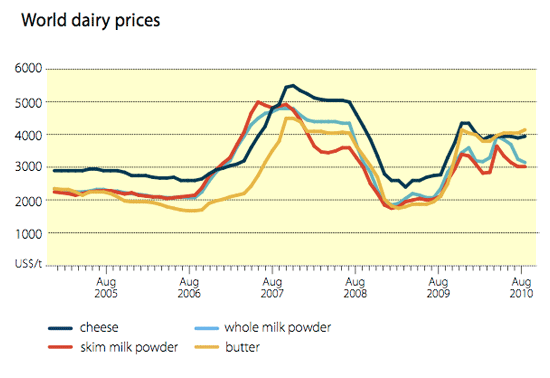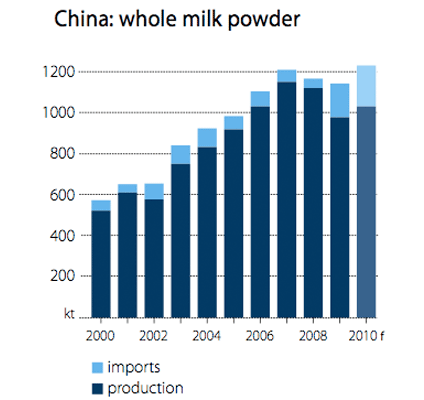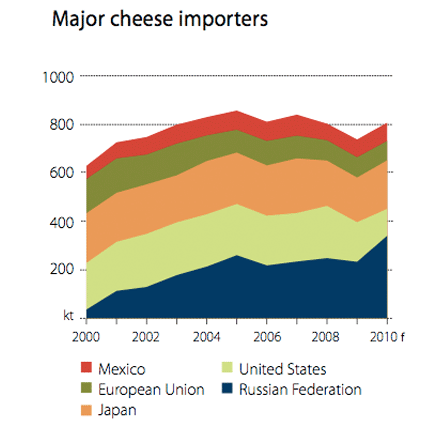



Australian Commodities: Global Dairy
World prices for dairy products are forecast to average slightly higher in 2010–11 than in 2009–10. The world indicator price for cheese is forecast to increase by 3.5 per cent to average around US$3880 a tonne.World prices for skim milk powder and whole milk powder are both forecast to increase by 4 per cent in 2010–11 to average US$3072 a tonne and US$3350 a tonne, respectively. World butter prices are forecast to increase by 6.4 per cent to average US$3700 a tonne.
Growth in global demand for dairy products, particularly in Asia, the Middle East and North Africa, is expected to support prices in 2010–11. However, forecast higher production in the major producing and exporting countries is expected to partially offset the effect of increased demand and moderate the pressure for price increases.

World butter prices recovered in the second half of 2009, and have since remained closer to the highs of 2007–08. Firm import demand in the Russian Federation and the Middle East and a run-down in butter stocks in the major producing and exporting countries have placed upward pressure on butter prices. World prices for milk powders fluctuated in the first eight months of 2010, and since May 2010 have fallen by 18 per cent in response to an easing of world demand and the prospect of higher production in key exporting countries, particularly New Zealand.
Global milk output to increase
European UnionAlthough EU dairy farmers are likely to face higher feed grain prices in 2010–11 as a result of reduced grain export supplies in the Russian Federation, Ukraine, Kazakhstan and Canada, EU milk output is forecast to increase slightly in response to higher farm-gate milk prices. EU milk production declined by 2 per cent in the 2009–10 marketing year (April to March), as a result of unfavourable seasonal conditions in the second half of the year.
Since early June 2010, the European Union has undertaken a program to release butter and skim milk powder from intervention stores. By mid-September 2010, 23 435 tonnes of butter and 1700 tonnes of skim milk powder had been sold. Meanwhile, between May and the end of September 2010 the European Union plans to allocate 51 148 tonnes of butter and 65 290 tonnes of skim milk powder from intervention stocks under the ‘deprived persons’ program. Excluding products allocated under the ‘deprived persons’ scheme, as at mid-September 2010 the European Union held 1500 tonnes of butter and 190 300 tonnes of skim milk powder in intervention stores.
US milk production is forecast to rise by 1.3 per cent to 88.3 million tonnes in 2011, being driven by an increase in milk yield per cow. Since mid-2009, milk prices received by US farmers have increased by nearly 30 per cent, providing an incentive for some producers to expand herds. However, forecast higher feed grain prices in 2010 and 2011 are likely to limit the expansion in dairy cow numbers.
The dairy herd in the United States is forecast to decline by 2.4 per cent to 9.09 million head in the two years ending 2010. The fall in dairy cow numbers can be partly attributed to the herd retirement programs undertaken by Cooperatives Working Together. Around 200 000 dairy cows were slaughtered under this program in 2009 and it was announced in July 2010 that a further 34 000 cows would be slaughtered.
Commodity Credit Corporation stocks of skim milk powder, which had accumulated during 2009, declined from 120 000 tonnes in September 2009 to 725 tonnes in July 2010. These stocks were disposed of through domestic food aid programs. The United States increased its exports of dairy products in the first half of 2010 in response to a pick-up in export demand. However, with the prospect of increased exports of milk powders from New Zealand in 2010–11, US exporters are expected to face increased competition in key Asian markets, which will constrain growth in US exports.
Milk production in New Zealand is expected to increase by around 6 per cent in 2010–11. Over the past decade, milk production in New Zealand has grown by around 40 per cent. Most of the growth has occurred in the South Island, where beef and sheep farms have been converted to dairying.
The New Zealand dairy herd reached a record 4.6 million cows in June 2009, 5.4 per cent higher than in 2008. Dairy cow numbers are expected to rise by a further 2.4 per cent in 2010. In line with the increase in dairy cow numbers, New Zealand exports of whole milk powder have more than doubled since 2000, reaching 893 000 tonnes in 2009–10. This has been driven mainly by the strong growth in demand for milk powders in developing economies.
Global demand underpins dairy markets
Global consumption of dairy products increased in the second half of 2009–10, mainly reflecting continuing economic recovery in emerging and developing economies, such as the Russian Federation, non-OECD Asia, the Middle East and North Africa. Despite an assumed slowing in world economic activity in the second half of 2010–11, global demand and trade in dairy products is expected to remain relatively firm.
World trade in milk powders in 2010–11 will depend on further increases in import demand in ASEAN and China. China’s imports of whole milk powder increased nearly fourfold to 176 000 tonnes in 2009, representing around 12 per cent of global trade in whole milk powder. The Chinese melamine contamination in 2008 affected consumer confidence in domestically produced dairy products and, as a result, milk production fell sharply in 2009.

Demand for imports remained strong in the first four months of 2010 and were 80 per cent higher than the corresponding period in 2009. Strong Chinese demand for whole milk powder is expected to continue for the remainder of 2010, with imports expected to exceed those in the same period of 2009. However, China’s milk production is beginning to recover from the sharp decline in 2008 and farmers are likely to rebuild herds. Further growth in milk production in 2011 may reduce the demand for imported milk powders.
The world cheese market is expected to be supported by further increases in imports by the Russian Federation and Japan in 2010–11. However, imports of cheese by the United States are forecast to decline by around 30 per cent in 2010, as a result of the accumulation of relatively high stocks and weak domestic demand.
The Russian Federation is forecast to import around 340 000 tonnes of cheese in 2010. The recovery in Russian demand for dairy products has been reflected in higher cheese imports since early 2010, particularly from the European Union.

Unseasonably hot weather and drought conditions in some of the main agricultural areas of the Russian Federation in mid-2010 have led to a reduction in milk production. As a result, it is likely that imports of cheese, butter and milk powders will increase further over the remainder of 2010–11. Despite generally weak demand for dairy products in Japan, Japanese cheese imports are forecast to rise by 9 per cent to 200 000 tonnes in 2010. Australian exports of cheese to Japan increased by 20 per cent to 89 850 tonnes in 2009–10, accounting for slightly more than half of total Australian cheese exports.
September 2010

